The Eleven Coolest Things in Starlog #002: Gene Roddenberry Has a Big Pipe, and Bigfoot Is Just Big
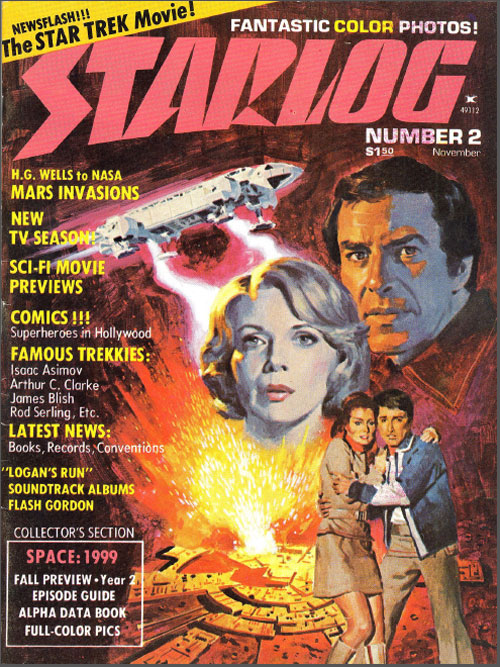 |
The second issue of Starlog was published in September of 1976, three months after the premiere issue. It would be quarterly for another issue before bumping up to eight times a year in January of 1977, not reaching coveted monthly status until the 20th issue in April of 1979, by which point the post-Star Wars boom was fully underway and there were more than enough new movies and shows to cover.
But in the second issue, Starlog was still finding its way, mostly by looking back. So, let’s look back at Starlog looking back! As always, if you’d like to read along at home, the full run of Starlog is available over at the Internet Archive, and here’s the first installment of this series.
1. The Most Exciting Picture of the 1976.
From the inside cover. If you weren’t there at the time, it’s impossible to convey just what a big deal the whole “Bigfoot-on-The Six Million Dollar Man and The Bionic Woman” was. So big that by the time I saw the episode in syndication in the early 1980s, it was still a very big deal.
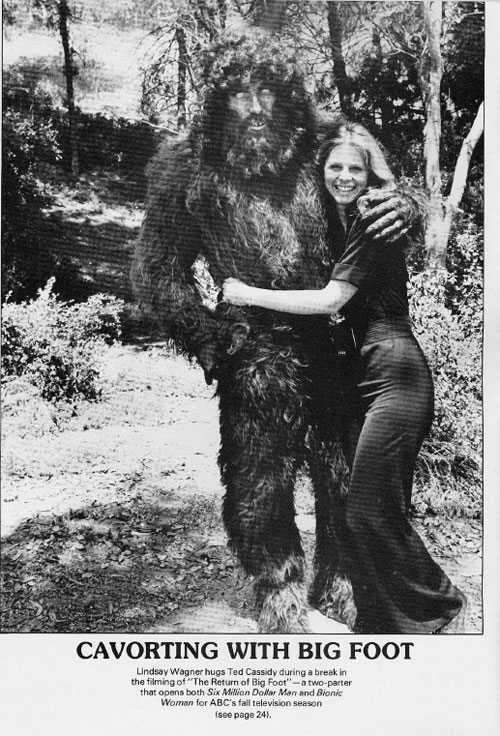 |
In a just world, this would have been an even more popular poster than the Farrah Fawcett one.
2. The Editor Is Contrary about 2001: A Space Odyssey.
In the “From the Bridge” column at the beginning, Editor-in-chief David Houston is worried about what he sees as a trend in sci-fi to emphasize flash over substance. (Again, this is before he or anyone else knew what a huge, game-changing deal Star Wars would be.) He calls out Stanley Kubrick’s 2001: A Space Odyssey in particular for setting a standard of sloppy storytelling. It’s an interesting perspective, and one that’s in opposition to the current belief that the film’s mysterious ending is now considered one of its greatest assets; that showing the aliens would have of robbed the movie of much of its power. I personally agree with the current belief that 2001 wouldn’t have quite the same punch if we saw the aliens, and this almost feels like what we’d now consider troll-bait. (I’ve peeked ahead to the next couple issues, and if anyone strongly disagreed with him, they didn’t bother to write – or Starlog didn’t bother to print it.)
 |
3. Luke Starkiller Kisses His Sister, But We Don’t Know That Yet.
From the “Log Entries” section, between tidbits on the never-to-be filmed When Worlds Collide remake and the still-filming King Kong remake, we find the very first mention in Starlog of what would eventually be known as Star Wars: Episode IV: A New Hope. In the first paragraph, an uncredited critic is quoted as saying, “…everything in science fiction you’ve always wanted to see on the screen but knew no-one would ever put there.” Funny how that sentence sounds like something George Lucas would write, huh?
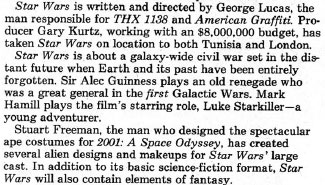 |
4. Gene Roddenberry’s Pipe is Just a Pipe.
An astonishingly fawning (and page-filling) profile of Star Trek creator Gene Roddenberry shames us all for not being more like him.
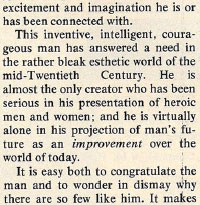 |
Gene loves tobacco almost as much as he loves adventure. Why aren’t you a script-writin’ pilot cop?
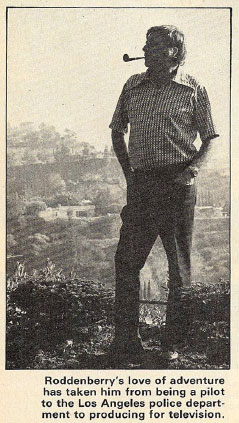 |
5. The Star Trek Movie Is Almost Certainly Totally Going To Happen, Probably!
This densely-packed article assures us that the on-again off-again Star Trek movie project, which had been scheduled to start shooting in July of 1976 but fell through, is now expected to go before the cameras in January of 1977. It’s still “untitled, unwritten, and uncast,” but that’s no reason not to be optimistic! Of course, the movie eventually would be scrapped in favor of a new television series called Star Trek: Phase II, which itself would be scrapped for a movie after Star Wars hit. See what you’ve done, Lucas? In any event, one of Roddenberry’s ideas for the movie was to make it a prequel, showing how Kirk and crew got their start. That concept fell through, and as history has shown us, would never, ever become the basis for a successful Star Trek movie.
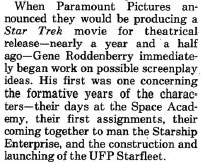 |
6. The Screenwriter of Planet of the Apes Chimes In.
Two more pages are filled in the “Famous Trekkies: What They Say About Star Trek” spread. (More about the word “Trekkie” in a moment.) 2001: A Space Odyssey scribe Arthur C. Clarke goes on at some length about how great it is to live in television-free Sri Lanka, Gene Roddenberry (who may have a conflict of interest, y’know?) marvels at how the show keeps growing in popularity, and best of all, the recently deceased yet perennial gadfly Rod Serling used the opportunity to reveal one of his many revenge fantasies against network executives.
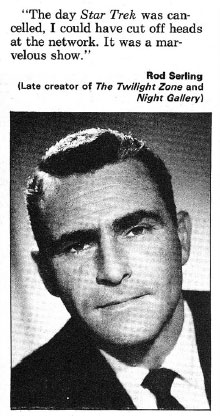 |
7. Complaints (or, Just Because I Want To Know Doesn’t Mean I’m The Kind Of Person Who Would Want To Know).
One of the things that must have been nice about putting together the first issue was there obviously couldn’t be a letters section, and thus they didn’t have to deal with readers nitpicking every little detail in their previous issue, since there wasn’t a previous issue. (Science!) But that luck necessarily ran out in Issue #002, as this gentleman from Florida has two comments (or corrections) about Starlog #001. It’s actually about six, but who’s counting? (For that matter, there are more than eleven cool things in this article.)
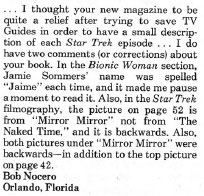 |
Another Floridian has nits to pick about the Star Trek episode guide, having cross-referenced it with Stephen E. Whitfield’s The Making of Star Trek. But just because he went to that trouble and wants to confirm such an esoteric detail about the show doesn’t make him a “Trekkie” like Rod Serling, thank you very much.
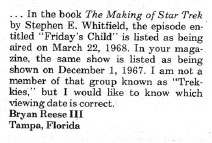 |
Oh, the T-word. Identity politics in fandom probably goes back farther than this, but no word may have ever been quite as hotly contested as “Trekkie,” which many (not unreasonably) saw as being a derogatory term used mockingly by the media. And it was used in that way, certainly, but others also wore it proudly. It’s the most obvious modern antecedent to the word “brony,” and heaven knows that back in the day, Star Trek fans were treated with about as much respect by the mainstream media as My Little Pony: Friendship Is Magic fans are now.
Mind you, I can hardly blame anyone for being on the “Don’t call me that!” train. I’m a huge My Little Pony: Friendship Is Magic fan (and have written about the show at some length for SF Weekly), but I eschew the term “brony” because of the distasteful root word “bro,” and how it perpetuates the notion that the show’s adult fans are overwhelmingly male – which is just not true, any more than it’s true that Star Trek fans are primarily boys. (The earliest and most vocal Star Trek fans were women.)
But that’s a war I generally don’t wage because it distracts from the discussion of the show itself, so my approach to the matter was to simply not use the word “brony” at all in my writing about the show. It mostly worked.
8. He’s Going to Save Every One of Us!
1976 was the height (or at least the girth) of a period known as “porno chic,” when skin flicks were almost respectable. Hence, the very second line of the large-type into this article about the old Flash Gordon serials makes a reference to the “imaginative pornographic satire” which was then “titillating adult audiences” from coast to coast.
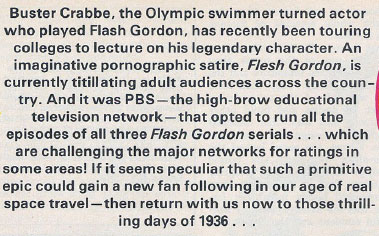 |
Nowadays, Flesh Gordon — which, in fairness, was largely softcore – is mostly remembered for the talent who worked behind the scenes on effects, particularly Rick Baker (who would go on to do An American Werewolf in London) and Greg Jein and Mike Minor (various incarnations of Star Trek). Over at Trailers From Hell, Mick Garris did a commentary on the trailer, which is largely SFW.
It’s now common knowledge that George Lucas had originally wanted to make a Flash Gordon movie after American Graffiti but couldn’t get the rights, so he made Star Wars instead. He later split the difference (sorta) by including a clip from the Flash Gordon serial at the beginning of the rejiggered director’s cut of his first feature, THX-1138.
But as Starlog’s episode guide to Flash Gordon demonstrates, there’s no doubt of the serial’s continued influence on Star Wars, particularly when it comes to prequel names.
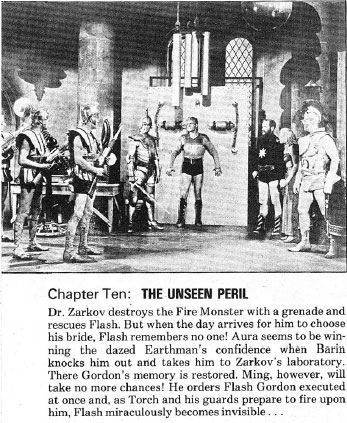 |
9. So, Can Superhero Movies Be Serious, Or What?
Mostly a rebuke of the bad reputation given to live-action superhero movies by the Adam West Batman series, citing The Six Million Dollar Man and The Bionic Woman as high standards for comic heroes in movie and television. (Also, you know, Bigfoot.) Plus, what would eventually become Superman: The Movie is still deep in pre-production, and Kal-El has an excellently blaxploitation-style nickname. After all, he is The Man (of Steel, or otherwise).
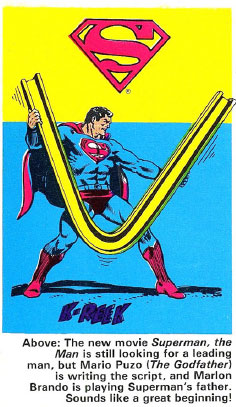 |
10. He Is Still Not Spock.
While famously refusing to return to Star Trek, whatever incarnation it might take, Leonard Nimoy nonetheless had a pretty decent sci-fi career going on. He would have a major role in 1978’s Invasion of the Body Snatchers (one of the best sci-fi movies of the 1970s, and one of the best movies about San Francisco in general), and then there was In Search Of…, in which he loaned his gravitas to some hardcore hokum.
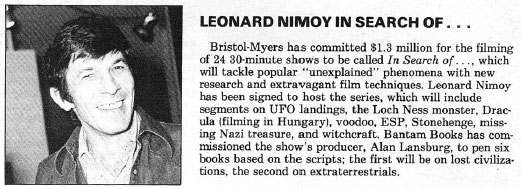 |
In a decade full of great synth-based television themes, In Search Of… had one of the very best. And it’s always made me happy that Amelia Earhart was so prominent.
The entire series is viewable for free on YouTube, including — oh yeah, you know it — an episode on Bigfoot. Seriously, folks, that was a big thing.
11. The Classifieds Reveal a Vast Nimoy-Bigfoot Conspiracy.
While not quite as robust yet as other magazines (particularly Rolling Stone, which I covered in a previous article), the first instance of classifieds and mail-order ads in Starlog are still a peek into a completely extinct form of capitalism.
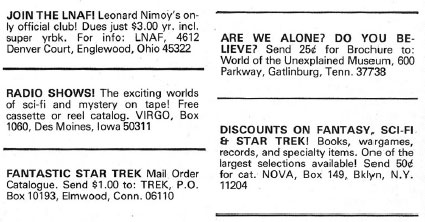 |
Oh, how I’d love to see that cassette-or-reel catalog of old radio shows! I wouldn’t want to go back to the way things were, and I’m glad that the entire run of the great sci-fi show X-1 is available for free online, but still, there was a certain tingle that came from receiving a mail-order catalog, especially it because it usually took so long to arrive you’d forgotten you’d sent away for it in the first place.
And then there’s the ad for the World of the Unexplained Museum in Tennessee. In addition to the ad itself being nice and vague in that 1970s-mysticism way, Kirk D. over at the Secret Fun Blog reports that the Museum was in operation until 1985. It was originally called the Museum of Witchcraft & Magic, but people got cranky about that name, as people will.
Theme Park Review has some high-quality scans of a Museum brochure, and look who’s their big celebrity spokesperson: Leonard Nimoy! Whether this was before or during In Search Of… is uncertain; they refer to him as being from Star Trek, but he was never not going to be associated with the show, much to his chagrin. (This brochure did not appear in Starlog, but is no less cool.)
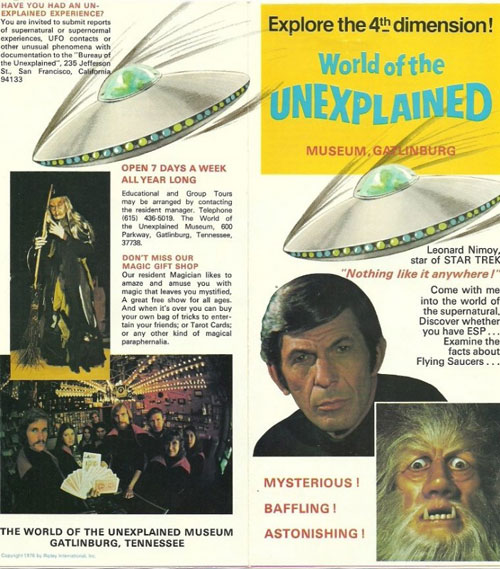 |
And, yeah, Bigfoot was there. Bigfoot was everywhere.
Coming Up In Starlog #003: The real Enterprise is unveiled (and an opportunity lost), a full report from the “Star Trek Bi-Centennial-10 Convention,” plenty of spaceship eye-candy, and not quite as much Bigfoot.
